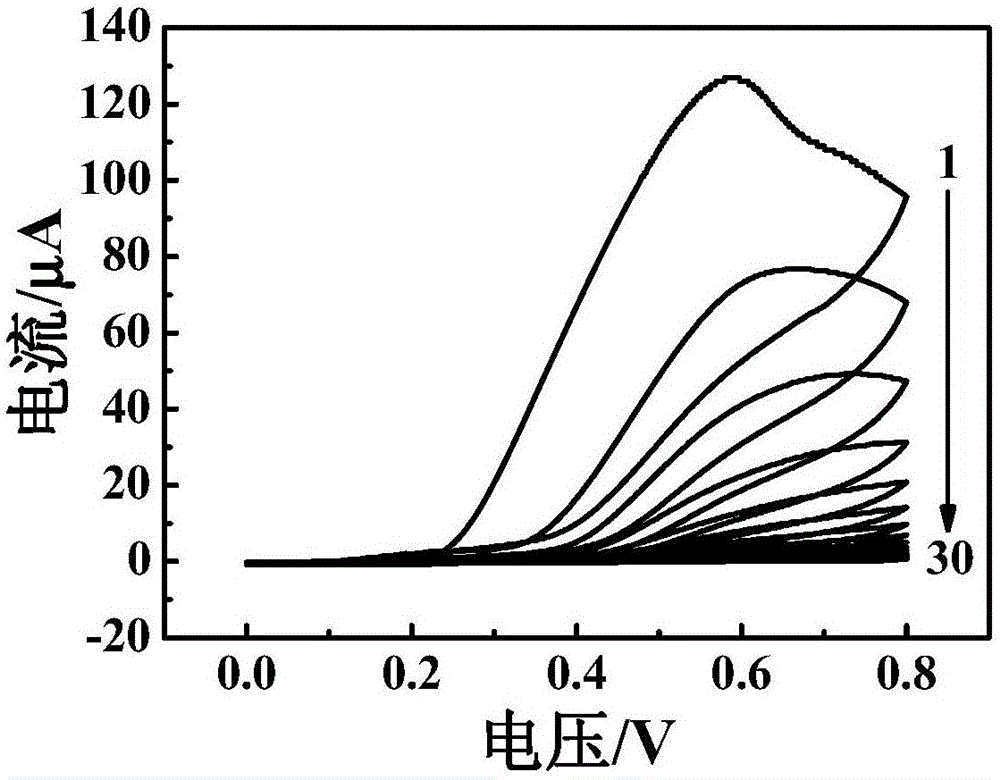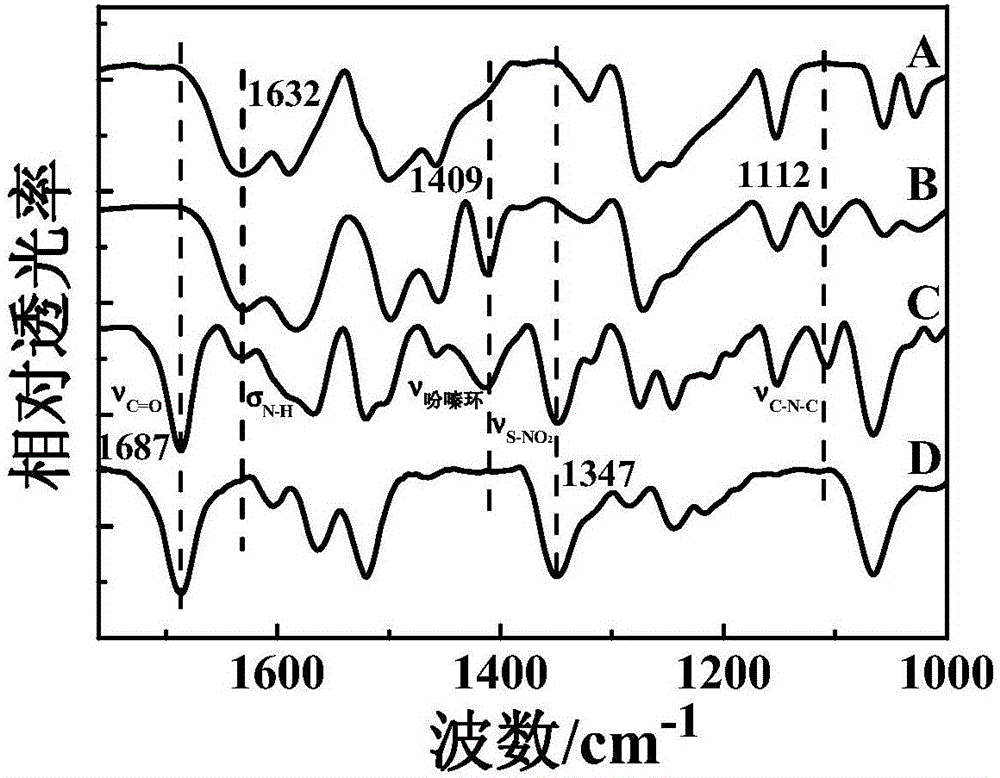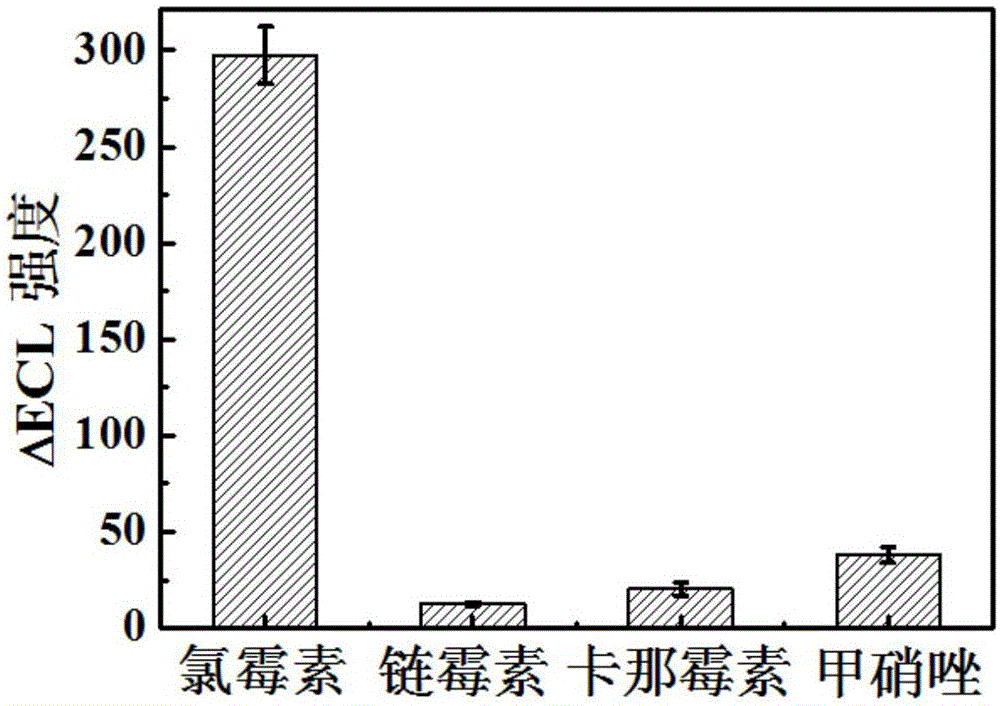Chloramphenicol molecular imprinting electrochemical luminescence sensor and chloramphenicol detection method thereof
A technique of molecular imprinting and chloramphenicol
- Summary
- Abstract
- Description
- Claims
- Application Information
AI Technical Summary
Problems solved by technology
Method used
Image
Examples
Embodiment 1
[0069] 1.1 Synthesis of poly-o-phenylenediamine-chloramphenicol film
[0070] First, the gold electrode was polished with 0.05 μm alumina powder, and the treated gold electrode was ultrasonically oscillated in ethanol and distilled water for 5 min, rinsed with distilled water, and dried for later use.
[0071] 0.0646g chloramphenicol and 0.0316g o-phenylenediamine are dissolved in 20mLpH and be that the amount concentration of 5.2 substance is in the acetic acid buffer solution of 0.1mol / L, obtain chloramphenicol and o-phenylenediamine maximum concentration and be 10mmol / L respectively, The acetic acid buffer solution is used as the electrolyte, the Ag / AgCl electrode is used as the reference electrode, the platinum electrode is used as the counter electrode, and the gold electrode is used as the working electrode. Cyclic voltammetry is used for scanning, the voltage range is 0-0.8V, and the scanning speed is 0.05V. / s, and the number of scanning circles was 30 circles, and a p...
Embodiment 2
[0080] 0.323g chloramphenicol and 0.079g o-phenylenediamine are dissolved in the acetic acid buffer solution that 20mLpH is 5.2 and the amount concentration of substance is 0.05mol / L, and the final concentration that obtains chloramphenicol is 50mmol / L, and the final concentration of o-phenylenediamine 25mmol / L, using the acetic acid buffer solution as the electrolyte, the Ag / AgCl electrode as the reference electrode, the platinum electrode as the counter electrode, and the graphite electrode as the working electrode, using cyclic voltammetry to scan, the voltage range is 0-0.8V, The scanning speed was 0.05V / s, and the number of scanning circles was 40, and a poly-o-phenylenediamine-chloramphenicol film was obtained on the surface of the gold electrode.
[0081] Rinse the poly-o-phenylenediamine-chloramphenicol film on the surface of the gold electrode with 0.01mol / LNaOH solution, rinse for 30min, and wash away the chloramphenicol in the poly-o-phenylenediamine-chloramphenicol ...
Embodiment 3
[0083] 0.162g chloramphenicol and 0.158g o-phenylenediamine are dissolved in 20mLpH and be 5.2 substance concentration in the acetic acid buffer solution of 0.2mol / L, obtain chloramphenicol final concentration and be 25mmol / L, o-phenylenediamine final concentration 50mmol / L, using acetic acid buffer solution as electrolyte, Ag / AgCl electrode as reference electrode, platinum electrode as counter electrode, and platinum electrode as working electrode, using cyclic voltammetry to scan, the voltage range is 0-0.8V, The scanning speed was 0.05V / s, and the number of scanning circles was 20, and a poly-o-phenylenediamine-chloramphenicol film was obtained on the surface of the gold electrode.
[0084] Rinse the poly-o-phenylenediamine-chloramphenicol film on the surface of the gold electrode with 0.01mol / L HCl solution, rinse for 15min, and wash away the chloramphenicol in the poly-o-phenylenediamine-chloramphenicol film, and obtain the chloramphenicol Molecularly imprinted electroche...
PUM
| Property | Measurement | Unit |
|---|---|---|
| Wave number | aaaaa | aaaaa |
| Concentration | aaaaa | aaaaa |
Abstract
Description
Claims
Application Information
 Login to View More
Login to View More - R&D
- Intellectual Property
- Life Sciences
- Materials
- Tech Scout
- Unparalleled Data Quality
- Higher Quality Content
- 60% Fewer Hallucinations
Browse by: Latest US Patents, China's latest patents, Technical Efficacy Thesaurus, Application Domain, Technology Topic, Popular Technical Reports.
© 2025 PatSnap. All rights reserved.Legal|Privacy policy|Modern Slavery Act Transparency Statement|Sitemap|About US| Contact US: help@patsnap.com



